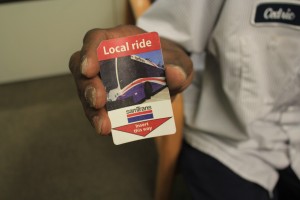Hear more about this story and how it developed on the Peninsula Report podcast.

In the warmth of the Safe Harbor emergency homeless shelter, Cedric is smiling. It’s 3 o’clock on a chilly November afternoon, and he just returned from his new job in the food service industry. The South San Francisco shelter provides him a sleeping cot, but the source of his grin is a less visible safety net — the collection of palm-size transit tickets he uses to commute to and from work.
Cedric asked to be identified only by his first name because his employer does not know he is homeless. Six months ago, he was sleeping in a parking garage in Daly City for nearly 10 months, he said, and before that in a flimsy tent along the freeway in South San Francisco for nearly a year.
The San Mateo County Board of Supervisors’ recent vote to continue a free SamTrans ticket program for clients of Safe Harbor – one of two short-term emergency shelters in the county – makes it easier for Cedric and others to hold a job or look for work, as well as to find housing, get to medical appointments or attend school.
It costs the county $240,000 a year to provide 30,000 one-way adult tickets, according to Christine Dunn, public information officer for the San Mateo County Transit District. Under the program, homeless clients of Safe Harbor, which is part of the nonprofit agency the Samaritan House, can receive four one-way adult tickets for SamTrans daily, if they qualify.
The 2011 San Mateo County Homeless Census and Survey counted 2,149 homeless people in the county, including those in shelters and on the streets. The number represented a 17 percent spike from the 2009 survey after a decrease the previous two years. East Palo Alto, Menlo Park, Redwood City, San Mateo and South San Francisco reported the highest levels of homelessness.
When asked in the 2009 survey what was keeping them from becoming employed, 22 percent of those surveyed said a lack of affordable transportation.
The census is a product of the Housing Our People Effectively (HOPE) plan, which states that its goal is to end homelessness in the county by 2015. The San Mateo County Human Services Agency plans to conduct another census of the homeless population in January.
With its 90 beds full “100 percent of the time,” Safe Harbor reports strong demand for the SamTrans tickets. Shelter Director Tracey Smith said between 55 and 70 clients use the tickets each day. The shelter is located on SamTrans property, with a bus stop just outside the front door.
“SamTrans already donates the property for it and their secondary support is the transportation [tickets]. So it’s a great three-way support system for the homeless individuals,” said Laura Bent, director of the Samaritan House, the parent organization of Safe Harbor.
The free SamTrans tickets are for qualifying shelter clients only. Case managers specializing in financial stability, housing, health or mental health meet with clients to determine their need and then design a strategy to help them overcome homelessness. Generally, people who cannot afford the bus tickets are guaranteed them; clients who have cars often receive the tickets, too, because they lack money to afford the gas.
“They hold those bus tickets near and dear to their heart,” Cedric said. “It’s their only means of transportation.”
Many shelter clients such as Cedric find employment through using the transit tickets, Smith said. Between July 2011 and June 2012, Safe Harbor helped 44 clients find jobs. The year before, 57 clients became employed.
Eric Brown, the lead case manager, said he can’t imagine operating as successfully without the free transportation. “Just imagine what they would need to do to get to their appointments without the bus tickets,” he said.
Brown has worked at the shelter for more than six years. One of his current cases involves a young married couple. The couple’s home was foreclosed on about two years ago, around the same time the husband became disabled and the wife was laid off from her job.
“They’re a very proud couple,” Brown said. “At one time they had some friends who found out they were homeless and wanted to make a donation to them while they were here. They declined the donation.” Soon after coming to Safe Harbor, the wife secured a job with the help of the transit passes. It’s a starting point for their family, Brown said.
Both Brown and Smith said there’s a shortage of resources for homeless single men in the county because, as Smith explained, “there are more women and children shelters — way more.”
As an emergency and transitional shelter, Safe Harbor is open to four types of people: those who need cots during inclement weather; cot clients brought in by the police through homeless outreach programs; long-term emergency clients who can stay 30 to 60 days, depending on their circumstances; and long-term transitional emergency clients who can stay for another six months, if they qualify.
Whether a client stays for one day or the maximum of eight months, all services at the shelter are free, which means a bunk-bed cot, a hot shower and one meal a day – although “there’s always food around,” Smith said. Several cakes and two boxes of bruised bananas sat under a nearby window as proof.
[youtube]0MuQ7vSDMn4[/youtube]
